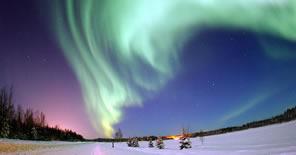Space Weather
Introduction
Space Weather encompasses the physical and phenomenological state of the natural space environment, including the Sun, the solar wind, the magnetosphere, the ionosphere and the thermosphere, and its interaction with the Earth. The associated discipline aims, through observation, monitoring, analysis, and modelling, at understanding the driving processes, predicting the state of the space environment and its disturbances, and forecasting their potential impact on ground-based or space-based infrastructure and on human life.
| The effects of Space Weather can range from damage to satellites arising from charged particles to disruption of power grids on Earth during geomagnetic storms, radio black-out on trans-polar aircraft routes, or disturbance of satellite positioning systems. Space Weather monitoring, study and applications are more and more important with the increasing use of space in day-to-day life for telecommunications, observation and navigation. | 
|
| Aurora Borealis is a visible space weather phenomenon |
WMO's involvement in Space Weather
In 2008, a report on the potential scope, cost and benefit of a WMO activity in support of international coordination of Space Weather services, was prepared by the WMO Space Programme (SP-5, WMO-TD N° 1482).
In June 2008, the WMO Executive Council (EC-LX) noted the considerable impact of Space Weather on meteorological infrastructure and important human activities. It acknowledged the potential synergy between meteorological and Space Weather services to operational users. The Council agreed that WMO should support international coordination of Space Weather activities and urged WMO Members to provide corresponding resources through secondments and Trust Fund donations.
In May 2010, WMO established the Interprogramme Coordination Team on Space Weather (ICTSW) with a mandate to support Space Weather observation, data exchange, product and services delivery, and operational applications. As of May 2016, ICTSW involves experts from 26 different countries and 7 international organizations.
In May 2011, the World Meteorological Congress (Cg-16) acknowledged the need for a coordinated effort by WMO Members to address the observing and service requirements to protect the society against the global hazards of Space Weather.
In July 2014 the potential space weather services to international air traffic navigation were discussed at the conjoint session of the WMO Commission for Aeronautical Meteorology (CAeM) and the Meteorological Division of the International Civil Aviation Organization (ICAO).
In May 2015, the World Meteorological Congress (Cg-17) took note of the Four-year Plan for WMO Coordination of Space Weather Activities developed by ICTSW in consultation with CAeM and the Commission for Basic Systems (CBS). Congress agreed that WMO should undertake international coordination of operational space weather monitoring and forecasting with a view to support the protection of life, property and critical infrastructures and the impacted economic activities in an optimized overall effort.
The 68th session of the executive Council (EC-68) in 2016 approved the Four-year Plan for WMO’s Coordination of Space Weather Activities 2016-2019 (FYP2016-19) and requested CAeM and CBS to establish an Inter-Programme Team on Space Weather Information, Systems and Services (IPT-SWeISS). This team is continuing with the work of ICTSW initiated to fulfill the tasks identified in the FYP2016-19.
Four-year Plan for WMO’s Coordination of Space Weather Activities 2020-2023
(English - French - Russian - Spanish - Arabic - Chinese) was drafted by IPT-SWeISS and approved by the Eighteenth World Meteorological Congress (Cg-18) in 2019. The implementation of space weather services and applications aligned with the FYP2020-23 is expected to provide significant benefits to WMO Members, in terms of more precise observations and improved.
In November 2021, the Expert Team on Space Weather (ET-SWx) was established under the Infrastructure Commission at its Management Group meeting and reporting to the Standing Committee on Data Processing for Applied Earth System Modelling and Prediction (SC-ESMP) in order to benefit from the Global Data Processing and Forecasting System (GDPFS) end-to-end systems model in support of the development of operational services. ET-SWx is tasked to coordinate with relevant WMO bodies the development of WMO Technical Regulations and guidance and other relevant documents on all aspects related to space weather. It follows work done by IPT-SWeISS, however with a broader mandate.
(Click here for details on ET-SWx status and activities)
Related links
- International Space Environment Service (ISES). The main objective of ISES is to facilitate international monitoring and prediction of the space environment. The ISES web site includes links to thirteen Space Weather Regional Warning Centres and Associate Centres.
- International Space Weather Initiative (ISWI). An international cooperation program to advance space weather science and education.
